Archive:Scientific research and development services statistics - NACE Rev. 2
- Data from October 2015. Most recent data: Further Eurostat information, Main tables and Database.
This Statistics Explained article is outdated and has been archived - for recent articles on structural business statistics see here.
This article presents an overview of statistics for the scientific research and development services sector in the European Union (EU), as covered by NACE Rev. 2 Division 72. It belongs to a set of statistical articles on 'Business economy by sector' .
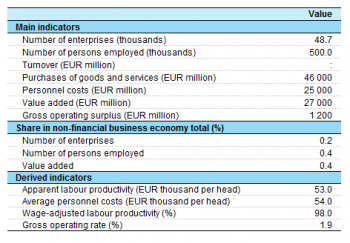
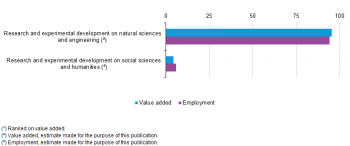
(% share of sectoral total) - Source: Eurostat (sbs_na_1a_se_r2)


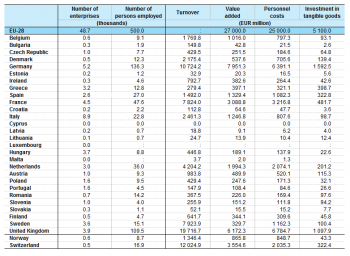
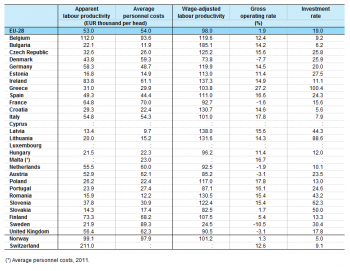

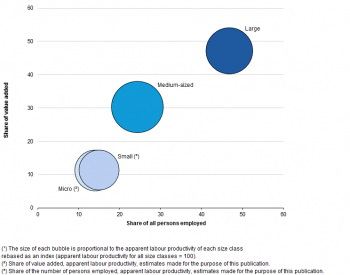
(% share of sectoral total) - Source: Eurostat (sbs_sc_1b_se_r2)

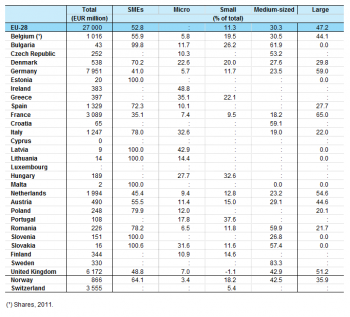
Main statistical findings
Structural profile
Scientific research and development services (Division 72) is a relatively small activity. There were 48.7 thousand enterprises operating with scientific research and development services as their main activity in the EU-28 in 2012; note that this includes only enterprises that have the provision of research and development services as their main activity and does not reflect the research and development function of enterprises in other activities. Together these specialist research and development enterprises employed 500 thousand persons, approximately 0.4 % of the total number of persons employed in the non-financial business economy (Sections B to J and L to N and Division 95) and 4.4 % of the workforce for professional, scientific and technical activities (Section M). They generated EUR 27 billion of value added which was also approximately 0.4 % of the non-financial business economy total and 4.5 % of the professional, scientific and technical activities total.
The apparent labour productivity of the EU-28’s scientific research and development services sector in 2012 was EUR 53.0 thousand per person employed, above the non-financial business economy average (EUR 46.2 thousand per person employed) and also slightly above the professional, scientific and technical activities average (EUR 52.0 thousand per person employed). Average personnel costs within the EU-28’s scientific research and development services sector were EUR 54.0 thousand per employee, reflecting the relatively high level of qualifications held by many persons within the workforce. This was the second highest level of average personnel costs among the seven NACE divisions that make up the professional, scientific and technical activities (where the average was EUR 44.3 thousand per employee) and considerably higher than the non-financial business economy average (EUR 32.4 thousand per employee).
As average personnel costs exceeded apparent labour productivity, the wage-adjusted labour productivity ratio for the EU-28’s scientific research and development services sector was below 100 % in 2012: standing at 98.0 % this sector’s wage-adjusted labour productivity ratio was the second lowest among all of the NACE divisions within the non-financial business economy, higher only than the ratio observed for the repair of computers and personal and household goods (Division 95).
The gross operating rate (the relation between the gross operating surplus and turnover) of the EU-28’s scientific research and development services sector was very low, at 1.9 % in 2012. This was the third lowest rate of profitability (using this measure) among any of the non-financial business economy NACE divisions in 2012, higher only than manufacture of coke and refined petroleum products (Division 19) and air transport (Division 51).
Sectoral analysis
Scientific research and development services are split according to NACE between those services concerning natural sciences and engineering (Group 72.1) and those concerning social sciences and humanities (Group 72.2). The research and experimental development on natural sciences and engineering subsector was considerably larger, accounting for 77.6 % of the EU-28’s scientific research and development services enterprise population, 94.2 % of its workforce, and an even higher share (95.6 %) of its value added in 2012. EU-28’s data on apparent labour productivity and average personnel costs on the subsectors level are available neither for 2012 nor 2011; the most recent data for 2010 show that the research and experimental development on natural sciences and engineering subsector recorded a significantly higher level of apparent labour productivity (EUR 51.1 thousand per person employed) when compared with the corresponding ratio for research and experimental development on social sciences and humanities subsector (EUR 30.0 thousand per person employed). Wage-adjusted labour productivity ratios for both activities in 2012 reached parity (100 %), indicating that value added per person employed just covered average personnel costs per employee. Indeed, both subsectors recorded the joint fifth lowest wage-adjusted labour productivity ratio among any of the NACE groups for which data are available within the EU-28’s non-financial business economy in 2012.
Gross operating rates for the two subsectors that form the EU-28’s scientific research and development activities differed significantly: while the research and experimental development on social sciences and humanities subsector recorded the gross operating rate almost double the EU-28’s average for the non-financial business economy (16.6 %), profitability for the research and experimental development on natural sciences and engineering subsector, using this measure, stood only at 1.5 %. As such, in 2012 the gross operating rate of the research and experimental development on natural sciences and engineering subsector was the fourth lowest across all of the NACE divisions within the non-financial business economy.
Country analysis
The scientific research and development services sector was one of two activities (at the NACE division level) within the professional, scientific and technical activities sector where Germany made the largest contribution to EU-28 value added. The German share of 29.4 % was the highest contribution made by any of the Member States to EU-28 value added within the seven NACE divisions that constitute professional, scientific and technical activities. Furthermore, Germany had the highest share of EU-28 value added for both subsectors within the scientific research and development services sector. The United Kingdom accounted for a 22.9 % share of value added in the scientific research and development services sector, while France was the only other Member State to record a double-digit share (11.4 %).
Despite value added being highly concentrated in Germany, Slovenia was the most specialised EU Member State in the scientific research and development services sector in 2012, as 0.9 % of its non-financial business economy value added was generated in these activities. The relative importance of the scientific research and development services sector was even higher in Switzerland, providing 1.2 % of non-financial business economy value added: when compared with the EU-28 average this was the third highest degree of specialisation in Switzerland across any of the NACE divisions that compose the non-financial business economy. Greece (0.7 %), the Netherlands, the United Kingdom, Germany (all 0.6 %), Belgium and Romania (both 0.5 %) were the other Member States that were relatively specialised within the scientific research and development services sector.
The exceptionally low wage-adjusted labour productivity ratio recorded for the EU-28’s scientific research and development services sector in 2012 was reflected in low wage-adjusted labour productivity ratios for most of the EU Member States, as nine of them posted rates below parity (100 %) indicating that average personnel costs were higher than apparent labour productivity. Nevertheless, wage-adjusted labour productivity ratio of 185.1 % was observed for Bulgaria and five other countries recorded the ratios between 130 % and 140 % in 2012. As such, Bulgaria was the only EU Member State which reported that its wage-adjusted labour productivity ratio for the scientific research and development services sector was above its non-financial business economy average.
For the gross operating rate the performance of the EU Member States in the scientific research and development services sector was even more varied in 2012. Six of the EU Member States for which data are available — France, the Netherlands, the United Kingdom, Austria, Denmark and Sweden — recorded negative profitability (using this measure). By contrast, the highest gross operating rate for the scientific research and development services sector in 2012 was recorded for Greece (27.2 %) and in other 17 EU Member States it stood between 10 % and 20 %; this was also the case for Switzerland.
Size class analysis
Contrary to many of the professional, scientific and technical activities, the EU-28’s scientific research and development services sector was dominated by large enterprises — perhaps unsurprising given the investment that is often required to conduct scientific research and development. Large enterprises (employing 250 or more persons) in the EU-28’s scientific research and development services sector employed 233.8 thousand persons (thereby accounting for 46.8 % of the sectoral workforce) and generated value added of EUR 12.7 billion (47.2 % of the sectoral value added).
Relative importance of the different size classes within the scientific research and development services sector (as measured by employment and value added) increased in relation to the average size of enterprises. The highest levels of apparent labour productivity within the EU-28’s scientific research and development services sector in 2012 were recorded for medium-sized enterprises (EUR 67.4 thousand per person employed) and for large enterprises (EUR 54.5 thousand per person employed).
Given the relative importance of the larger EU Member States within the scientific research and development services sector, an analysis of EU-28 data by enterprise size class is strongly influenced by the structure of this activity within Germany and the United Kingdom. Some 60.4 % of the German workforce within the scientific research and development services sector was employed by a large enterprise and this proportion rose to 63.1 % in the United Kingdom; these were the two highest shares across all of the Member States for which data are available.
Large enterprises in Germany provided an almost identical share (59.0 %) of sectoral value added (as they did for sectoral employment), while the relative importance of large enterprises in the United Kingdom was somewhat lower (51.2 %). The share of large enterprises in the scientific research and development services sector peaked in France (the third largest producer in this sector) at 65.0 %, while the Netherlands was the only other country (among those for which data are available) where they were responsible for more than half of the generated value added in 2012.
Data sources and availability
The analysis presented in this article is based on the main dataset for structural business statistics (SBS) and size class data, all of which are published annually.
The main series provides information for each EU Member State as well as a number of non-member countries at a detailed level according to the activity classification NACE. Data are available for a wide range of variables.
In structural business statistics, size classes are generally defined by the number of persons employed. A limited set of the standard structural business statistics variables (for example, the number of enterprises, turnover, persons employed and value added) are analysed by size class, mostly down to the three-digit (group) level of NACE. The main size classes used in this article for presenting the results are:
- small and medium-sized enterprises (SMEs): with 1 to 249 persons employed, further divided into;
- micro enterprises: with less than 10 persons employed;
- small enterprises: with 10 to 49 persons employed;
- medium-sized enterprises: with 50 to 249 persons employed;
- large enterprises: with 250 or more persons employed.
Context
This article presents an overview of statistics for the scientific research and development services sector in the EU, as covered by NACE Rev. 2 Division 72. This division includes the activities of various types of research and development. Basic research is experimental or theoretical work undertaken primarily to acquire new knowledge of the underlying foundations of phenomena and observable facts, without particular application or use in view. Applied research is original investigation undertaken in order to acquire new knowledge, directed primarily towards a specific, practical aim or objective. Experimental development is systematic work, drawing on existing knowledge gained from research and/or practical experience, directed to producing new materials, products and devices, to installing new processes, systems and services, and to improving substantially those already produced or installed. These can be divided between the different subject areas, for example, biotechnology, natural sciences, engineering and technology, medical sciences, agricultural sciences, social sciences and humanities.
This NACE division is composed of two groups:
- research and experimental development on natural sciences and engineering (Group 72.1);
- research and experimental development on social sciences and humanities (Group 72.2).
The information that is presented in this article does not include market research activities, which are classified within NACE as part of the advertising and market research sector (Division 73).
See also
- Other analyses of the business economy by NACE Rev. 2 sector
- Professional, scientific and technical activities
- Structural business statistics introduced
Further Eurostat information
Publications
- European business - facts and figures (online publication)
Main tables
Database
- SBS – services (sbs_serv)
- Annual detailed enterprise statistics - services (sbs_na_serv)
- Annual detailed enterprise statistics for services (NACE Rev. 2 H-N and S95) (sbs_na_1a_se_r2)
- SMEs - Annual enterprise statistics by size class - services (sbs_sc_sc)
- Services by employment size class (NACE Rev. 2 H-N and S95) (sbs_sc_1b_se_r2)
- Annual detailed enterprise statistics - services (sbs_na_serv)
- SBS - regional data - all activities (sbs_r)
- SBS data by NUTS 2 regions and NACE Rev. 2 (from 2008 onwards) (sbs_r_nuts06_r2)
Dedicated section
Source data for tables and figures (MS Excel)
Other information
- Decision 1578/2007/EC of 11 December 2007 on the Community Statistical Programme 2008 to 2012
- Regulation (EC) No 295/2008 of 11 March 2008 concerning structural business statistics